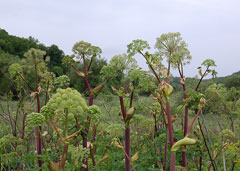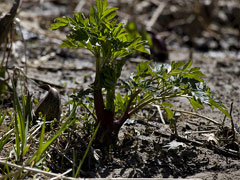 |
|
http://flickr.com/photos/52421717@N00/3601878244 |
 |
| http://flickr.com/photos/dcaloren/ |
Translate this page:
Summary
Physical Characteristics

 Angelica atropurpurea is a PERENNIAL growing to 3 m (9ft 10in).
Angelica atropurpurea is a PERENNIAL growing to 3 m (9ft 10in).
See above for USDA hardiness. It is hardy to UK zone 4 and is not frost tender. It is in flower from July to August, and the seeds ripen from August to September. The species is hermaphrodite (has both male and female organs) and is pollinated by Insects. The plant is self-fertile.
Suitable for: light (sandy), medium (loamy) and heavy (clay) soils. Suitable pH: mildly acid, neutral and basic (mildly alkaline) soils. It can grow in semi-shade (light woodland) or no shade. It prefers moist soil.
UK Hardiness Map
US Hardiness Map
Synonyms
Archangelica atropurpurea. (L.)Hoffm.
Plant Habitats
Woodland Garden Dappled Shade; Shady Edge;
Edible Uses
Edible Parts: Leaves Root Shoots Stem
Edible Uses:
Young shoots and leaf stalks - raw or cooked[55, 105, 177]. When boiled in two lots of water they form a vegetable that strongly resembles celery. They can be peeled and eaten in salads or blanched and cooked like asparagus[183]. The stems can also be candied and used as a sweetmeat[2]. Root, leafstalks and stems - candied[177, 183].
References More on Edible Uses
Medicinal Uses
Plants For A Future can not take any responsibility for any adverse effects from the use of plants. Always seek advice from a professional before using a plant medicinally.
Carminative Diaphoretic Emmenagogue Sedative Stomachic Tonic
A tea made from the leaves is carminative and stomachic[222]. It is also used in the treatment of colds, rheumatism etc[222]. The seed and roots can also be used and have a stronger effect[222]. The plant has similar properties to angelica, A. archangelica, though it is inferior since it is less aromatic[4]. The root is carminative, diaphoretic, emmenagogue, sedative, stomachic and tonic[257]. An infusion has been used in the treatment of fevers, colds, flatulent colic and other stomach disorders, obstructed menses and as a general tonic for women[257]. Externally it has been used as a gargle for sore throats and mouths and as a poultice for broken bones, swellings etc[257]. It has also been used, both internally and externally, as a treatment for rheumatism[257].
References More on Medicinal Uses
The Bookshop: Edible Plant Books
Our Latest books on Perennial Plants For Food Forests and Permaculture Gardens in paperback or digital formats.

Edible Tropical Plants
Food Forest Plants for Hotter Conditions: 250+ Plants For Tropical Food Forests & Permaculture Gardens.
More

Edible Temperate Plants
Plants for Your Food Forest: 500 Plants for Temperate Food Forests & Permaculture Gardens.
More

More Books
PFAF have eight books available in paperback and digital formats. Browse the shop for more information.
Shop Now
Other Uses
References More on Other Uses
Cultivation details
Requires a deep moist fertile soil in dappled shade or full sun[200]. Plants are reliably perennial if they are prevented from setting seed[200].
References Carbon Farming Information and Carbon Sequestration Information
Temperature Converter
Type a value in the Celsius field to convert the value to Fahrenheit:
Fahrenheit:
The PFAF Bookshop
Plants For A Future have a number of books available in paperback and digital form. Book titles include Edible Plants, Edible Perennials, Edible Trees,Edible Shrubs, Woodland Gardening, and Temperate Food Forest Plants. Our new book is Food Forest Plants For Hotter Conditions (Tropical and Sub-Tropical).
Shop Now
Plant Propagation
Seed - best sown in a cold frame as soon as it is ripe since the seed only has a short viability[200]. Seed can also be sown in the spring, though germination rates will be lower. It requires light for germination[200]. When large enough to handle, prick the seedlings out into individual pots and grow them on in a cold frame for their first winter, planting them out into their permanent positions in the spring. The seed can also be sow in situ as soon as it is ripe.
Other Names
If available other names are mentioned here
Native Range
NORTHERN AMERICA: Canada (Québec, Nova Scotia, Ontario, New Brunswick, Newfoundland and Labrador), United States (Connecticut, Indiana, Maine, Massachusetts, Michigan, New Hampshire, New Jersey, New York, Ohio, Pennsylvania, Rhode Island, Vermont, West Virginia, Illinois (north), Iowa (north), Minnesota (east), Wisconsin, Delaware, Kentucky (c.), Maryland, North Carolina (Haywood Co.), Tennessee)
Weed Potential
Right plant wrong place. We are currently updating this section.
Please note that a plant may be invasive in one area but may not in your area so it's worth checking.
Conservation Status
IUCN Red List of Threatened Plants Status :

| Related Plants
|
| Latin Name | Common Name | Habit | Height | Hardiness | Growth | Soil | Shade | Moisture | Edible | Medicinal | Other |
| Angelica acutiloba | Dong Dang Gui | Perennial | 0.7 |
6-9
| | LMH | SN | M | 2 | 1 | |
| Angelica anomala | | Perennial | 1.5 |
-
| | LMH | SN | M | 0 | 2 | |
| Angelica archangelica | Angelica, Norwegian angelica | Biennial | 1.5 |
4-8
| | LMH | SN | M | 3 | 3 | 2 |
| Angelica crucifolia | | Perennial | 0.8 |
-
| | LMH | SN | M | 2 | 0 | |
| Angelica dahurica | Bai Zhi | Biennial/Perennial | 1.8 |
-
| | LMH | SN | M | 2 | 3 | |
| Angelica decursiva | | Perennial | 1.5 |
-
| | LMH | SN | M | 2 | 2 | |
| Angelica edulis | | Perennial | 3.0 |
-
| | LMH | SN | M | 2 | 0 | |
| Angelica genuflexa | Kneeling Angelica | Perennial | 1.0 |
-
| | LMH | SN | M | 2 | 1 | 1 |
| Angelica gigas | Giant Angelica, Purple Parsnip, Korean Angelica | Perennial | 1.8 |
4-8
| M | LMH | SN | M | 2 | 2 | |
| Angelica glauca | | Perennial | 2.0 |
-
| | LMH | SN | M | 2 | 1 | 1 |
| Angelica japonica | | Perennial | 1.0 |
-
| | LMH | N | M | 3 | 0 | |
| Angelica keiskei | | Perennial | 1.2 |
-
| | LMH | SN | M | 2 | 0 | |
| Angelica koreana | | Perennial | 1.0 |
-
| | LMH | SN | M | 2 | 0 | |
| Angelica laxiflora | | Perennial | 0.0 |
-
| | LMH | SN | M | 0 | 1 | |
| Angelica megaphylla | | Perennial | 2.0 |
-
| | LMH | SN | M | 2 | 0 | |
| Angelica montana | | Perennial | 1.5 |
-
| | LMH | SN | M | 2 | 0 | |
| Angelica polymorpha | | Perennial | 1.0 |
-
| | LMH | SN | M | 2 | 2 | |
| Angelica pubescens | Du Huo | Perennial | 1.8 |
6-9
| | LMH | SN | M | 2 | 3 | |
| Angelica sinensis | Dang Gui - Dong Quai - Chinese Angelica | Perennial | 1.0 |
6-9
| | LMH | SN | M | 0 | 5 | 1 |
| Angelica sylvestris | Wild Angelica,Woodland angelica | Biennial | 1.5 |
4-8
| | LMH | FSN | M | 3 | 2 | 1 |
| Angelica uchiyamanae | | Perennial | 0.0 |
-
| | LMH | SN | M | 0 | 1 | |
| Angelica ursina | | Perennial | 3.0 |
-
| | LMH | SN | M | 2 | 0 | |
| Aralia chinensis | Chinese Angelica Tree, Pumila Spirea, Chinese Astilbe | Shrub | 3.5 |
4-8
| M | LMH | FS | M | 2 | 2 | |
| Aralia elata | Japanese Angelica Tree, Angelica Tree | Tree | 6.0 |
4-9
| M | LMH | SN | M | 3 | 2 | 2 |
| Aralia mandschurica | Manchurian Angelica Tree | Shrub | 3.5 |
4-8
| | LMH | SN | M | 2 | 2 | |
| Aralia spinosa | Hercule's Club, Aralia spinosa, American Angelica Tree, Hercules' Club, Devil's Walking Stick | Tree | 9.0 |
5-9
| S | LMH | FS | M | 2 | 2 | 2 |
|
Growth: S = slow M = medium F = fast. Soil: L = light (sandy) M = medium H = heavy (clay). pH: A = acid N = neutral B = basic (alkaline). Shade: F = full shade S = semi-shade N = no shade. Moisture: D = dry M = Moist We = wet Wa = water.
Now available:
Food Forest Plants for Mediterranean Conditions
350+ Perennial Plants For Mediterranean and Drier Food Forests and Permaculture Gardens.
[Paperback and eBook]
This is the third in Plants For A Future's series of plant guides for food forests tailored to
specific climate zones. Following volumes on temperate and tropical ecosystems, this book focuses
on species suited to Mediterranean conditions—regions with hot, dry summers and cool, wet winters,
often facing the added challenge of climate change.
Read More
Expert comment
Author
L.
Botanical References
43200235
Links / References
For a list of references used on this page please go here
Readers comment
| Add a comment |
|
If you have important information about this plant that may help other users please add a comment or link below. Only comments or links that are felt to be directly relevant to a plant will be included. If you think a comment/link or information contained on this page is inaccurate or misleading we would welcome your feedback at [email protected]. If you have questions about a plant please use the Forum on this website as we do not have the resources to answer questions ourselves.
* Please note: the comments by website users are not necessarily those held by PFAF and may give misleading or inaccurate information.
To leave a comment please Register or login here All comments need to be approved so will not appear immediately.
|
Subject : Angelica atropurpurea
|
|
|
|